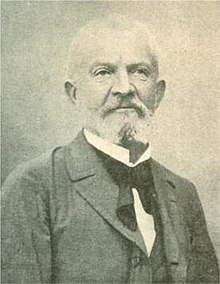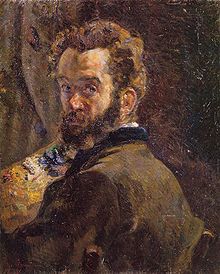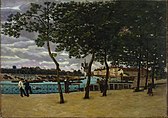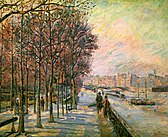Armand Guillaumin
Armand Guillaumin | |
|---|---|
 | |
| Born | Jean-Baptiste Armand Guillaumin 16 February 1841 Paris, France |
| Died | 26 June 1927 (aged 86) |
| Nationality | French |
| Known for | Painting |
| Movement | Impressionism |
| Signature | |
 | |

Armand Guillaumin (French: [aʁmɑ̃ ɡijomɛ̃]; February 16, 1841 – June 26, 1927) was a French Impressionist painter and lithographer.
Biography
[edit]Early years
[edit]Born Jean-Baptiste Armand Guillaumin in Paris, he worked at his uncle's lingerie shop while attending evening drawing lessons. He also worked for a French government railway before studying at the Académie Suisse in 1861. There, he met Paul Cézanne and Camille Pissarro, with whom he maintained lifelong friendships. While he never achieved the stature of these two, his influence on their work was significant. With these two friends, Guillaumin exhibited at the Salon des Refusés in 1863.The three artists frequently painted in each other's company in the 1870s; for a time, Guillaumin and Cézanne had studios next door to each other on the Île Saint-Louis in Paris. In 1873, Cézanne made the only etchings of his career, one of them depicting Guillaumin[1] (see Gallery below).
Guillaumin was a member of the Société anonyme des artistes peintres, sculpteurs et graveurs (later dubbed Impressionistes) from the start and he participated in six of the eight Impressionist exhibitions: 1874, 1877, 1880, 1881, 1882 and 1886.[2] In the eyes of contemporary critics, he became known for his assured brushstroke and use of bold colours. In 1886, an astute critic, Félix Fénéon, called him a "furious colourist";[3] By the 1890s, his palette had grown even bolder, less faithful to nature. He was a Fauve a decade before Fauvism.
Full-time painter
[edit]In 1886, he became a friend of Vincent van Gogh, whose brother, Theo, exhibited and sold some of his works. Vincent held Guillaumin's work in high regard, commenting on it in at least 36 letters written from 1888 to 1890.[4] In the mid 1880s, Guillaumin's studio was a meeting place for young artists such as Paul Gauguin, Paul Signac and Georges Seurat. Guillaumin was finally able to quit his government job and concentrate on painting full-time in 1891, when he won 100,000 francs in the state lottery.[2]
Exhibitions and Collections
[edit]Armand Guillaumin was given large solo exhibitions at many of the top Parisian galleries, including Galeries Durand-Ruel in 1895, Galerie Ambroise Vollard in 1897, Galerie Bernheim-Jeune in 1901 and 1906, and Galerie Paul Rosenberg in 1908. Noted for their intense colours, Guillaumin's paintings are represented in major museums around the world. These include the Musée d’Orsay (48 works) and Petit Palais (91 works) in Paris, the Tate Britain in London, major museums in Germany, Russia, the Netherlands and Spain, the Metropolitan Museum of Art in New York, the National Gallery of Art in Washington DC, the Art Institute of Chicago, and many others in the U.S.A,, Canada, Israel and Japan.[5] Private collectors, many of whom owned dozens of works, bought up his production through the 1920s. Noteworthy among these are Count Armand Doria, Dr. Paul Gachet, Théodore Duret, Gustave Geffroy, Louis Vauxcelles, Tadamasa Hayashi, Sergei Shchukin, Chester Dale and Paul Mellon.
Legacy
[edit]Guillaumin is best remembered for his landscapes of Paris, the Creuse département, and the area around Les Adrets-de-l'Estérel near the Mediterranean coast in the Provence-Alpes-Côte d'Azur region of France. Guillaumin was called the leader of the École de Crozant, a diverse group of painters who came to depict the landscape in the region of the Creuse around the village of Crozant. One of these depictions, titled Landscape in Crozant, is housed in the Art Institute of Chicago.[6] His bust is in the square near the village church in Crozant.[7]
Death
[edit]Armand Guillaumin died in 1927 in Orly, Val-de-Marne just south of Paris.
Gallery
[edit]-
The Seine, 1867
-
Landscape, 1870
-
View of the Seine, Paris, 1871, Oil on canvas, 126.4 × 181.3 cm., Museum of Fine Arts, Houston
-
Sunset at Ivry (Soleil couchant à Ivry), 1873, 81 cm x 65 cm. Oil on canvas. Musée d'Orsay
-
La Place Valhubert, 1875
-
River Scene, c. 1890
-
Les Pommiers à Damiette, 1893, Aberdeen Art Gallery
-
The Haystacks, c. 1890-1895
-
Agay by Jean-Baptiste Armand Guillaumin, circa 1901
-
Snowy landscape in Crozant
-
Landscape with Ruins, 1897
-
Paul Cézanne, Guillaumin Thinking, 1873
References
[edit]- ^ Rewald, John (1980). The history of impressionism. Secker & Warburg. ISBN 0-436-41149-0. OCLC 931306671.
- ^ a b "Armand Guillaumin", Oxford Art Online
- ^ Gray, Christopher (1991). Armand Guillaumin (2nd ed.). Chester, Conn.: Brush-Mill Books. p. 33.
- ^ "Vincent van Gogh Letters". Retrieved 5 April 2023.
- ^ Montgomery, Blair (March 2, 2022). "Collections". Armand Guillaumin, From the Shadows into the Light. Retrieved April 3, 2022.
- ^ "Art Institute of Chicago Collections". The Art Institute of Chicago.
- ^ Jean-Paul Labourdette, Dominique Auzias (3 September 2008). "Creuze". Best of France 2008-2009 Petit Fute. Petit Futé. p. 606. ISBN 978-2-7469-2225-9.
External links
[edit]- Works by or about Armand Guillaumin at the Internet Archive
- A biography of Armand Guillaumin.
- www.armandguillaumin.net, a comprehensive study of the artist, his colleagues, exhibitions and collections
- Armand Guillaumin Bio - Findlay Galleries
- www.armandguillaumin.org 260 works by Armand Guillaumin
- www.comiteguillaumin.com Authenticate a painting from Armand Guillaumin
- Impressionism: a centenary exhibition, an exhibition catalog from The Metropolitan Museum of Art (fully available online as PDF), which contains material on Guillaumin (p. 108-109)
- Signac, 1863-1935, a fully digitized exhibition catalog from The Metropolitan Museum of Art Libraries, which contains material on Guillaumin (see index)













